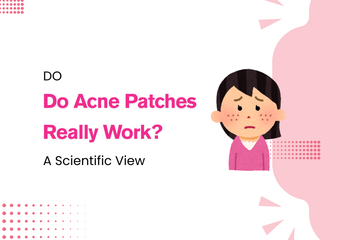Acne is a widespread skin condition that affects people of all ages. While there are various methods to treat acne, one of the most popular options in recent years is the use of acne patches. These small, often transparent patches are designed to be applied directly to pimples and are claimed to aid in faster healing. But, do acne patches really work? In this article, we’ll dive deep into the science behind acne patches, their benefits, how they work, and their effectiveness.
What Are Acne Patches?
Acne patches are small, adhesive patches that are applied directly to acne spots. Typically made from hydrocolloid, a material that helps to absorb excess fluid, these patches are often used as a spot treatment for pimples.
Acne patches are designed to protect the affected area from external contaminants and bacteria while speeding up the healing process. By using an acne patch, individuals can keep their pimples clean and free from external irritation, which can lead to further breakouts or scarring.
How Do Acne Patches Work?
Acne patches work by creating a protective barrier over pimples. This barrier has several key functions:
-
Absorbing excess moisture and pus: Hydrocolloid material in the patch absorbs the fluids released by pimples. This helps to reduce inflammation and accelerates the healing process.
-
Protecting the wound: Acne patches prevent external contaminants, dirt, and bacteria from coming into contact with the pimple. This protection is especially beneficial for those who tend to touch or pick at their pimples, which can cause further irritation or lead to scarring.
-
Promoting faster healing: By creating a moist environment, acne patches facilitate a process known as “moist wound healing,” which has been shown to speed up the healing of pimples.
In addition to these benefits, acne patches can serve as a visible reminder not to pick at the pimple, which helps reduce the risk of scarring and allows the acne to heal naturally. Similarly, if you're looking for an effective solution to manage menstrual pain, consider exploring the Matri Menstrual Pain Relief Device, designed to offer comfort and relief during your cycle.
Acne Patch Benefits
Acne patches provide several significant benefits that make them a popular choice among acne sufferers:
-
Non-invasive treatment: Acne patches are a non-medicated solution for acne, making them ideal for individuals who are looking for a simple and gentle treatment method. They don’t contain harsh chemicals, which can sometimes irritate sensitive skin.
-
Convenience and ease of use: Acne patches are easy to apply and require no additional effort. Simply clean the affected area, apply the patch, and leave it on for a few hours or overnight.
-
Reduces the urge to pick: One of the biggest benefits of acne patches is their ability to reduce the temptation to pick or squeeze pimples. Picking at pimples can lead to scarring, so the patch provides a protective barrier that discourages this behavior.
-
Discreet and comfortable: Acne patches are often thin and transparent, making them easy to wear under makeup or while going about daily activities. They provide a discreet way to treat acne without drawing attention.
-
Helps with acne wound protection: The patches act as a form of protection for the pimple, helping to speed up the healing process while keeping the area free from contaminants that could worsen the condition.
How Effective Are Acne Patches?
The effectiveness of acne patches largely depends on the type of acne being treated. Hydrocolloid acne patches are best suited for surface-level pimples or pustules. They may not be as effective for cystic acne, which forms deeper beneath the skin’s surface. However, for smaller, more superficial pimples, acne patches can significantly reduce the size, redness, and inflammation of the spot.
A study conducted by dermatologists found that acne patches can reduce the size of pimples and accelerate the healing process by absorbing fluids and creating a moist healing environment. The patches also offer the added benefit of preventing further irritation or infection, which can help prevent scarring.
Though the evidence suggests that acne patches are effective for certain types of acne, they should be used in conjunction with a proper skincare routine for the best results. Acne patches can aid in healing existing pimples but are not a long-term solution for managing acne.
Also Read - What Are Period Panties
How to Use Acne Patches Effectively
To get the most out of your acne patch, follow these steps:
-
Cleanse the skin: Start by cleaning your face with a gentle cleanser to remove dirt, oil, and makeup. Pat your skin dry before applying the patch.
-
Apply the patch: Once the skin is dry, peel the backing from the acne patch and place it directly over the pimple. Press gently to ensure it sticks to the skin.
-
Leave the patch on: Leave the patch on for several hours or overnight. The longer it is on, the more fluid it can absorb.
-
Remove and dispose: Once the patch has absorbed the fluid from the pimple, remove it and discard it. You may notice a reduction in the size and redness of the pimple.
-
Repeat as needed: If necessary, you can use another patch on the same pimple, or you can apply a patch to new pimples as they appear.
Are Acne Patches Suitable for Everyone?
Acne patches are generally suitable for most skin types, including sensitive skin. However, they are most effective for treating pimples that have come to a head, or pustules. They may not be as effective for deep, cystic acne. People with severe acne may need to consult a dermatologist for more targeted treatment options.
It’s important to remember that while acne patches provide a quick and convenient way to treat pimples, they should be used as part of a broader acne treatment plan. Using them alongside a consistent skincare routine that includes cleansing, exfoliating, and moisturizing can help to prevent future breakouts and improve skin health.
FAQs
1. How long should I leave an acne patch on my pimple?
Leave an acne patch on for several hours or overnight. The longer the patch is in place, the more fluid it can absorb from the pimple, helping it heal more quickly. Most patches work best when left on for at least six hours.
2. Do acne patches really work for all types of acne?
No. Acne patches are most effective for surface-level pimples or pustules. They may not work as well for deep cystic acne, which requires different treatment methods, such as oral medications or more targeted skincare solutions.
3. Can acne patches be worn under makeup?
Yes, acne patches are thin and discreet, so they can be worn under makeup without being noticeable. Just be gentle when applying makeup over the patch to avoid disturbing it or peeling it off.
4. Are acne patches safe for sensitive skin?
Yes, acne patches are safe for sensitive skin. They are typically made from hydrocolloid, a gentle material that does not contain harsh chemicals. However, it’s always a good idea to perform a patch test first to ensure you don't have an allergic reaction.
5. Can I reuse acne patches?
No, acne patches are designed for single use only. Once they have absorbed the fluid from a pimple, they should be removed and replaced with a new patch. Reusing a patch could lead to contamination and reduce its effectiveness.
6. How do acne patches prevent scarring?
Acne patches prevent scarring by protecting the pimple from bacteria and external irritation. They also reduce the temptation to pick or squeeze pimples, which is a common cause of scarring.
7. Are acne patches effective for reducing pimple size overnight?
Yes, acne patches are effective for reducing the size of pimples overnight. They absorb excess fluid and reduce inflammation, leading to smaller, less noticeable pimples after a few hours of use.
8. Can acne patches be used for whiteheads?
Yes, acne patches can be used for whiteheads. These patches are particularly effective for treating surface-level pimples that contain pus, such as whiteheads and pustules.
9. Can acne patches help with cystic acne?
No, acne patches are not effective for cystic acne, as this type of acne forms deeper beneath the skin's surface. Cystic acne often requires medical treatment, such as prescription medication or other dermatological treatments.
10. How often should I use acne patches?
You can use acne patches as needed, typically when you have a breakout or pimple. They can be worn overnight or for several hours during the day, depending on your preference and the severity of the pimple.







op3c4b